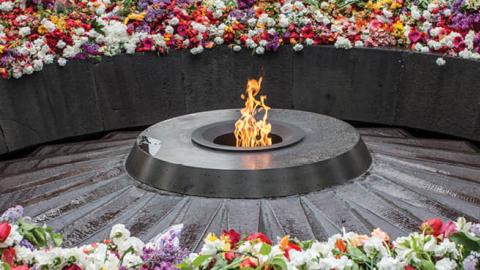April 24 has long been observed worldwide as Armenian Genocide Memorial Day. In 2021, President Joe Biden chose to formally acknowledge that the systematic murder of more than a million Armenian Christians by the Ottoman Empire was, in fact, a genocide.
“The American people honor all those Armenians who perished in the genocide that began 106 years ago today,” Biden explained. “Let us renew our shared resolve to prevent future atrocities from occurring anywhere in the world. And let us pursue healing and reconciliation for all the people of the world.”
Although Biden is the first U.S. President to recognize the genocide, he isn’t the first world leader to do so. During a Sunday sermon in April 2015, Pope Francis referred to the 1915 Turkish mass killings of Armenians as the “first genocide of the 20th century.” At the time, his papal declaration exploded into a diplomatic uproar. It infuriated Turkey’s Islamist President Recep Tayyip Erdogan, who “warned” the Pope against repeating his “mistaken” statement. But in fact, Pope Francis spoke for many if not most Christians around the world.
Those massacres cost 1.5 million Armenian Christians their lives, along with hundreds of thousands of Assyrian and Greek believers. The heartbreaking story began on April 24, 1915, when Turkish authorities arrested of Armenian professors, lawyers, doctors, clergymen and other elites in Constantinople (now Istanbul). Revered members of the community were jailed, tortured and viciously murdered in cold blood.
In fact, the abuses had begun earlier in April. But on the 24th, house searches were launched in earnest. The Ottomans claimed they were searching for weapons, accusing the Christians of arming themselves for a revolution. In those days, since most Turkish citizens kept firearms for hunting and self-defense, of course the Turks found many guns in Armenian homes. This served as their pretext for mass arrests.
I have written elsewhere of the terrors that followed. The family members who helplessly watched these home invasions – mostly women, children, the ill and the elderly – were then rounded up and informed that they would be “relocated.” Instead, they were herded like animals with whips and cudgels. And at gunpoint, they were sent on a death march to Nowhere.
The captives were provided with little or no food or water. Old people and babies were the first to die. Women were openly and repeatedly raped; mothers were gripped with insanity, helplessly watching their little ones suffer and succumb; more than a few took their own lives. Eyewitness accounts and photographs remain in circulation today, and they are heart wrenching. Corpses littered the roads; nude women were crucified; dozens of bodies floated in rivers.
On Jan. 5, 2015, Raffi Khatchadourian published a personal essay in The New Yorker about his Armenian grandfather, who somehow survived the genocide. He described the brutality:
Whenever one of them lagged behind, a gendarme would beat her with the butt of his rifle, throwing her on her face till she rose terrified and rejoined her companions. If one lagged from sickness, she was either abandoned, alone in the wilderness, without help or comfort, to be a prey to wild beasts, or a gendarme ended her life by a bullet.
In numerous accounts, the Armenian Genocide has been described not only as a genocide – which continued well past 1915 – but also as a jihad. Some Armenian women were even told they would be spared if they would convert to Islam. It is noteworthy that less than a year before the genocide’s beginning, on November 13, 1914, a call to jihad—a holy war against Christian “infidels” was officially announced: “The Ottoman Sultan Mehmed V, in his role as Caliph, along with his Sheikh-ul-Islam, issued a call for jihad against the Allied powers of Britain, France, Russia, Serbia, and Montenegro.”
In the eyes of today’s Armenians, that jihadi violence has never stopped. In October 2020 the combined armies of Azerbaijan and Turkey, reinforced by Syrian mercenaries, marched into Nagorno-Karabakh’s disputed Armenian enclave. Besides driving some 100,000 refugees from their homes, historic churches, ancient carved cross-stones called khachkars, monasteries, and other Christian shrines and properties were defaced, demolished, and dispossessed. The 2020 invasion of Nagorno-Karabakh was perceived by many Armenian Christians as the continuation of an Islamist jihad against them.
The Armenian genocide has also served as an inspiration to other mass killers. In 1939, as he planned his “Final Solution” to rid the world of Jews, Adolf Hitler notoriously said, “Who, after all, speaks today of the annihilation of the Armenians?”
Hitler definitely got that wrong – today more people are speaking of the Armenian annihilation than ever before. For decades, countless voices have cried out seeking its official recognition. And now, despite angry Turkish disapproval, on April 24, 2021 President Joe Biden’s voice was added to that chorus.
President Biden deserves thanks and applause for being the first U.S. President to accurately define the slaughter of 1.5 million Armenians. It was past time – after decades of American diplomatic waffling which included unkept promises by Presidents George W. Bush and Barack Obama – to call the Ottoman Empire’s pogroms by their proper name: The Armenian Genocide.
Read in Religion Unplugged

















